Roofing public adjusters are essential for maneuvering the complex process of roof damage insurance claims. They advocate for homeowners to guarantee they receive fair compensation for damages. They conduct thorough assessments of roof damage claims, determine necessary repairs or replacements, and facilitate the evidence-collection process.
Understanding insurance coverage, policy terms, and the role of adjusters is critical for successful claims. Effective communication with adjusters and proper documentation also aid in claim processing. By exploring the role of public adjusters in roof damage claims, homeowners can better navigate the process and potentially maximize their settlements, leading to a more favorable outcome.
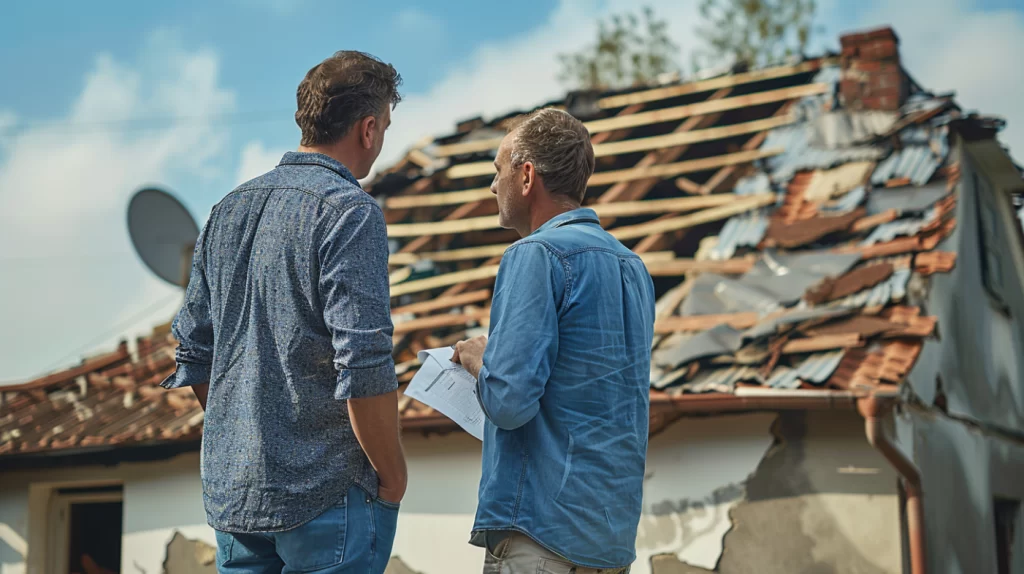
Key Takeaways
• Roofing public adjusters help homeowners navigate the roof damage insurance claim process, ensuring maximum compensation.
• Public adjusters thoroughly assess roof damage claims, determining necessary repairs or replacements.
• Effective communication with public adjusters is crucial for claim processing and advocating for homeowner rights.
• Public adjusters can facilitate evidence collection, including documentation of visible damage and maintenance records.
• Hiring a licensed public adjuster provides expert claims navigation and advocacy for maximum settlements.
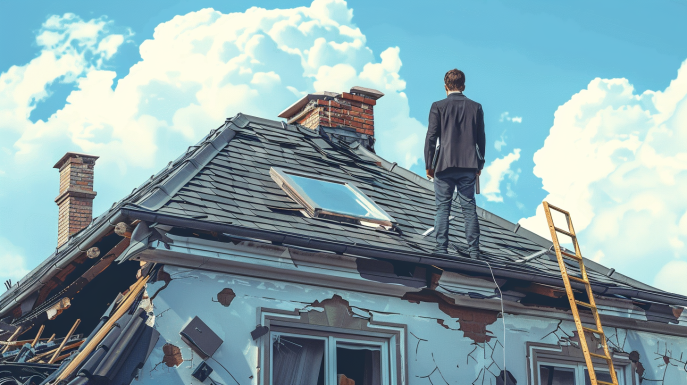
The Roof Damage Insurance Claim Process
The roof damage insurance claim process is a critical aspect of securing compensation for damaged or destroyed roofs. To navigate this process effectively, it is essential to understand the specifics of insurance coverage, including whether insurance companies pay for roof replacement and the role of roofing insurance adjusters in evaluating damage.
A clear understanding of the process, including insurance adjuster roof inspections and the nuances of roof storm damage insurance claims, can help homeowners achieve a successful claim outcome.
Do Insurance Companies Pay For Roof Replacement?
Insurance companies will typically cover roof replacement costs if damage occurs suddenly and accidentally, resulting from catastrophic events such as storms, hail, or other incidents that are usually outside of homeowner control or maintenance oversights. This is a significant aspect of the roof damage insurance claim process, as it determines the extent of financial assistance homeowners can receive.
A roofing public adjuster can help navigate the complexities of the claim, ensuring that all necessary documentation is submitted to the insurance company.
When evaluating roof damage, the following factors are considered:
- Sudden and accidental damage, such as from a storm or hail, rather than normal wear and tear
- Evidence of damage, including photographs and maintenance records
- Mitigation efforts taken by the homeowner to prevent further damage
- Compliance with policy terms, including deductibles and coverage limits
The Roofing Insurance Adjuster
How does the evaluation of roof damage claims unfold, and what role does the roofing insurance adjuster play in determining the extent of compensation for homeowners? The roof damage insurance claim process typically involves a thorough assessment of the damage by a roofing adjuster, who evaluates the extent of the damage and determines the necessary repairs or replacement. A public adjuster for roof claim can assist homeowners in maneuvering this process, guaranteeing that all necessary documentation is submitted to support the claim.
The roof insurance adjuster plays an essential role in evaluating the damage and determining the compensation amount. An independent roof adjuster may also be hired by the homeowner to provide an unbiased assessment of the damage. Effective communication with the insurance adjuster is vital to guarantee that the claim is processed efficiently and fairly. By understanding the role of the roofing insurance adjuster, homeowners can better maneuver the roof damage insurance claim process and advocate for their rights.
Insurance Adjuster Roof Inspections
Following a thorough assessment by a roofing insurance adjuster, an extensive roof inspection is conducted to gather detailed evidence of damage, validate the claim, and establish the basis for determining compensation.
This vital step in the roofing claims process involves a meticulous examination of the roof’s condition, including documentation of visible damage, such as missing shingles or leaks.

Key components of an insurance adjuster roof inspection include:
- Documenting visible damage through photographs and detailed notes
- Collecting evidence, such as maintenance records and repair estimates from a roofer
- Evaluating the extent of damage, including underlying issues not immediately visible
- Reviewing documentation of mitigation efforts to prevent further damage
A public adjuster specializing in roofing can facilitate this process, ensuring that all necessary evidence is collected and presented to support the claim. By working with a roof public adjuster, homeowners can navigate the complex claims process with confidence, knowing that their interests are being represented. The insurance adjuster’s findings will ultimately determine the settlement amount, making a thorough roof inspection a vital step in resolving roofing claims.
Roof Storm Damage Insurance Claims
The roof damage insurance claim process is initiated when a homeowner documents the extent of storm-related damage to their property, gathering essential evidence, such as photographs and maintenance records, to substantiate the claim. This process is vital in determining the validity and value of the claim.
A well-documented claim can considerably impact the outcome, ensuring that homeowners receive fair compensation for their losses.
| Claim Process Steps | Homeowner Responsibilities |
|---|---|
| Document damage | Gather photographs, maintenance records, and witness statements |
| File claim promptly | Submit claim within policy-specified timeframe |
| Mitigate further damage | Perform temporary repairs to prevent additional damage |
Homeowners must also file claims promptly, as insurance policies often have specific time limits for reporting storm damage. Insurance adjusters will assess the damage and verify the claim’s validity, focusing on sudden and accidental damage rather than wear and tear.
Effective communication with the insurance company and preparedness to appeal denied or undervalued claims are also vital in ensuring a successful outcome.
Your Insurance Company Has An Adjuster ... Shouldn’t You?
Our Expert Public Adjusters Work Exclusively For You To Ensure You Get The Highest Settlement Possible From Your Property Insurance Claim After A Disaster.
Roofing Adjusters: How A Public Adjuster For Roof Claims Can Benefit Homeowners
Understanding the potential relationships between public adjusters and roofing companies is a vital consideration for homeowners seeking the assistance of a public adjuster for roof claims.
In some instances, a public adjuster may also work for or have affiliations with a roofing company, which can raise questions about their impartiality and potential conflicts of interest.
Homeowners must explore the implications of such arrangements and how they may impact the adjuster’s ability to represent their interests effectively.
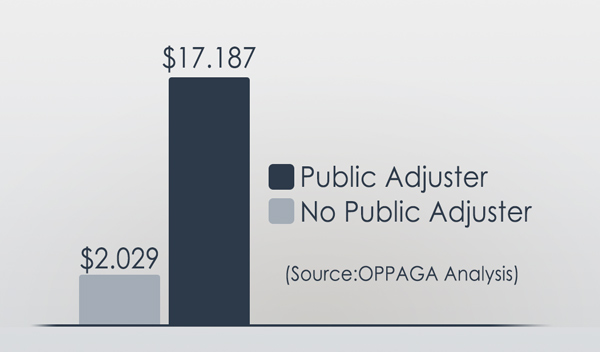
Can A Public Adjuster Also Work For A Roofing Company?
Some states, such as Texas, have enacted laws that strictly prohibit public adjusters from simultaneously working as contractors or having any affiliation with a roofing company, in order to maintain their impartiality and guarantee they exclusively represent the homeowner’s interests during the claims process. This is vital in ensuring that public adjusters remain unbiased and focused on securing the best possible outcome for homeowners.
The benefits of hiring a public adjuster who is not affiliated with a roofing company are numerous:
- Exclusive representation of the homeowner’s interests
- No potential conflicts of interest
- Unbiased assessment of roof damage and necessary repairs
- Maximum settlement amounts without undue influence from contractors
What Kind Of Roof Damage Is Covered By Insurance?
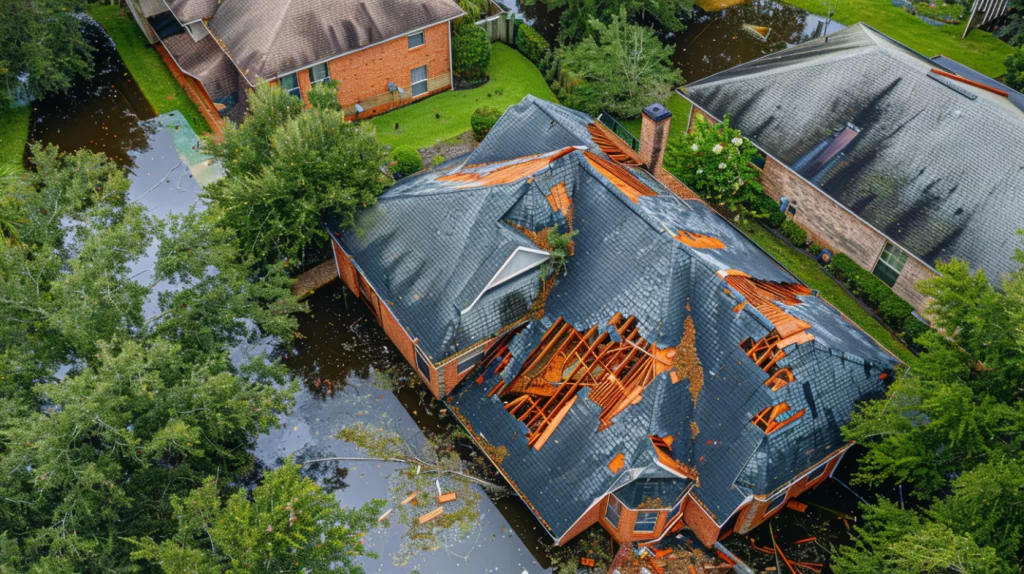
When evaluating roof damage, it is vital to identify the signs that indicate coverage under an insurance policy.
Typically, insurance companies cover damage resulting from sudden and accidental events, such as storms, hail, or falling objects, rather than wear and tear or maintenance-related issues.
Recognizing the distinction between covered and excluded damages is essential for homeowners to navigate the claims process effectively.
Signs Of Roof Damage
Roof damage that is sudden and accidental, such as that caused by storms, hail, or high winds, is typically covered by insurance, whereas damage resulting from gradual wear and tear or maintenance issues is often excluded from coverage. Homeowners should be aware of the common signs of roof damage that may be covered by insurance to guarantee timely reporting and documentation.
Some common signs of roof damage that may be covered by insurance include:
- Missing or broken shingles
- Leaks causing interior water damage
- Visible hail dents on roofing materials
- Dislodged or damaged flashing around chimneys, vents, or skylights
It is essential to document evidence of damage with photographs and obtain weather reports confirming storm events to substantiate claims. Homeowners should also review their policy details to understand their coverage limits and exclusions. By being proactive and reporting roof damage promptly, homeowners can improve the likelihood of a successful insurance claim.
How Do Roofing Companies Work With Insurance Companies?
In the event of a claim submission, the collaborative efforts between roofing companies and insurance adjusters are essential in evaluating damage and determining the scope of repairs required to restore a property to its pre-damage state.
Roofing companies often work closely with insurance adjusters to assess the extent of the damage and provide detailed estimates for repairs. To facilitate this process, many roofing contractors may request homeowners to sign agreements that allow them to negotiate directly with insurance companies on the homeowner’s behalf.

Proper documentation, including estimates and photographs of the damage, is vital for roofing companies to present a valid claim to insurance providers. Insurance policies typically cover sudden and accidental damage, prompting roofing companies to emphasize the urgency of repairs to support claims. By understanding the insurance policy terms and deductibles, homeowners can better navigate the negotiation process with both roofing companies and insurers, ultimately leading to a more successful outcome.
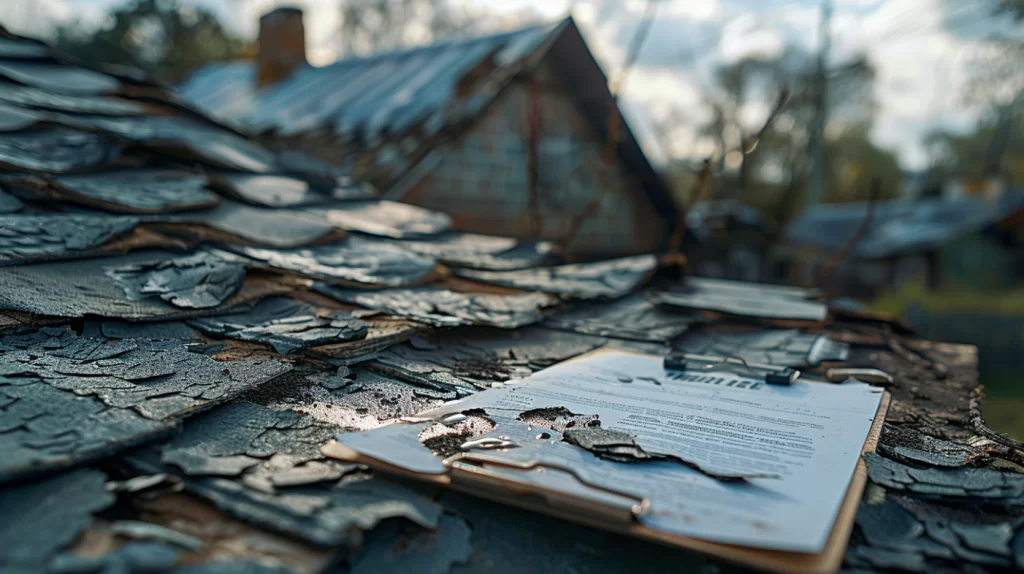
How Much Does Insurance Pay For Roof Replacement?
The amount insurance pays for roof replacement is a critical factor in the claims process, influenced by various factors such as roof depreciation, age, and policy specifics.
Insurance companies typically consider the roof’s age and condition when determining the payout, which may result in depreciation deductions for older roofs. Understanding these factors and how they impact insurance payouts is essential for homeowners maneuvering the roof replacement claims process.
Roof Replacement Insurance Depreciation
Typically, insurance companies calculate payouts for roof replacements based on the Actual Cash Value (ACV) method, which takes into account the depreciation of the roof due to age and wear and tear, potentially resulting in a lower payout than the full replacement cost. This means that the insurance company will assess the roof’s estimated lifespan and deduct the value lost due to age and condition, resulting in a payout that reflects the roof’s reduced value.
To better understand how depreciation affects roof replacement insurance payouts, consider the following key points:
- Depreciation is calculated based on the roof’s age, condition, and estimated lifespan.
- The Actual Cash Value (ACV) method takes into account depreciation, resulting in a potentially lower payout.
- Replacement Cost Value (RCV) coverage, if included in the policy, allows for reimbursement of the full replacement cost without depreciation deductions.
- Documenting the roof’s condition before damage occurs can help substantiate claims and potentially mitigate depreciation assessments.
Age Of Roof And Insurance
A homeowner’s insurance policy often takes the age of their roof into account when determining coverage and payout amounts for a roof replacement claim, which can considerably impact the final compensation received. Insurance companies typically apply depreciation to the value of older roofs, reducing the payout for roof replacement based on the roof’s age at the time of the claim.
For roofs older than 15-20 years, insurers may limit coverage or offer only a partial payout based on the remaining useful life of the roof.
| Roof Age | Depreciation | Payout Percentage |
|---|---|---|
| 0-5 years | 0% | 100% |
| 5-10 years | 20% | 80% |
| 10-15 years | 40% | 60% |
| 15-20 years | 60% | 40% |
| 20+ years | 80% | 20% |
Homeowners should carefully review their insurance policy terms regarding roof age and coverage limits to understand how much compensation they may receive for a roof replacement. Claims for roof replacement due to storm damage will likely be scrutinized for the roof’s condition prior to the incident, with insurers focusing on whether the damage was sudden and accidental.
How Often Will Insurance Pay For A New Roof?
Filing a claim for roof replacement is generally permissible once every five to seven years, contingent upon the specific terms of the homeowner’s insurance policy and the nature of the damage sustained.
Insurance companies typically cover roof replacements due to sudden and accidental damage, such as from storms, but do not cover normal wear and tear or maintenance issues.
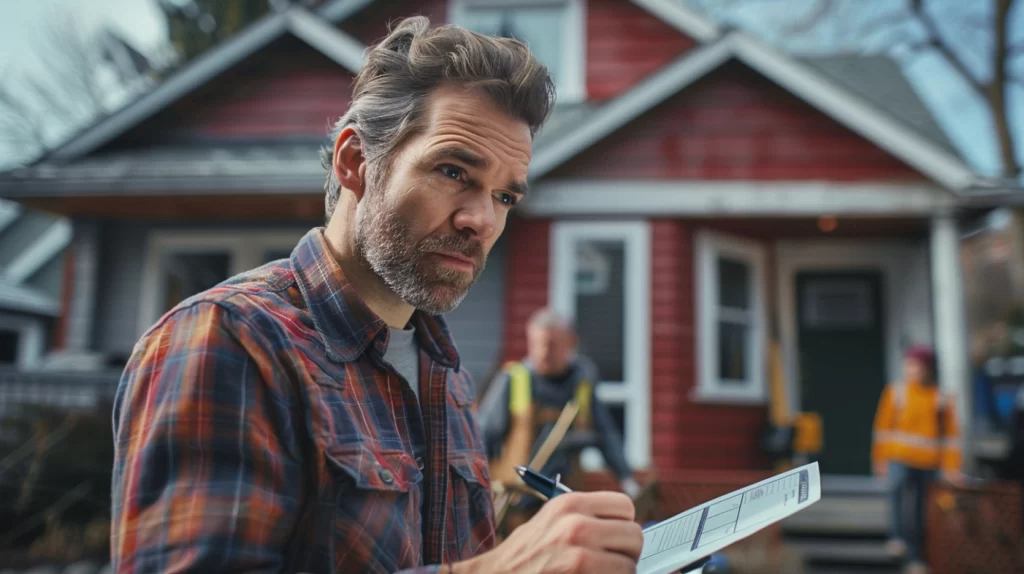
The frequency and amount of insurance payouts for roof replacements depend on various factors. Consider the following:
- The average payout for a roof replacement can vary greatly, often ranging from $5,000 to $30,000.
- Many insurance policies have specific clauses regarding roof age, with some covering replacements only if the roof is less than 15 years old at the time of the claim.
- Insurance companies may only pay a percentage of the roof’s value based on its depreciated value.
- The extent of the damage and the specifics of the policy also impact the total payout received for a replacement.
It is crucial for homeowners to review their insurance policies and understand the terms and conditions regarding roof replacement claims. By doing so, they can guarantee they receive fair compensation for their losses.
Your Insurance Company Has An Adjuster ... Shouldn’t You?
Our Expert Public Adjusters Work Exclusively For You To Ensure You Get The Highest Settlement Possible From Your Property Insurance Claim After A Disaster.
How To File A Claim For Roof Damage?

When dealing with roof damage, the first step in filing a successful insurance claim is to thoroughly review your policy to understand the specifics of your coverage, including any exclusions or limitations related to roof damage.
This essential step guarantees that you are aware of what is covered and what is not, avoiding potential disappointments or disputes during the claims process.
Next, document the roof damage with detailed photographs and written descriptions, capturing any signs of severity or related interior damage to support your claim. Gathering evidence of sudden and accidental damage, such as weather reports for storms or other events that caused the damage, is also critical for approval.
File the claim promptly by contacting your insurance company, providing all necessary documentation, and following their specific procedures for claims submission. Keeping a record of all communications with your insurer, including dates, times, and the names of representatives, will also help guarantee a smooth process.
How To Get A New Roof Without Paying Deductible?
Following a thorough review of insurance policy details and a well-documented claims submission process, homeowners facing roof damage may be left wondering about the possibilities for mitigating out-of-pocket expenses, particularly their policy deductible, when in need of a new roof.
It is vital to note that, in states like Texas, contractors are prohibited from waiving or absorbing deductibles, leaving homeowners responsible for paying their deductibles upfront.

Homeowners can consider the following options to potentially offset deductible costs:
- Explore financing options or payment plans provided by reputable contractors to manage out-of-pocket expenses more easily.
- Review policy details to identify any applicable provisions that may offer coverage for the deductible as part of specific endorsements.
- Document all communications and agreements related to deductible payments to protect against potential disputes or misunderstandings.
- Research local and state laws regarding deductible payments to guarantee compliance and avoid legal repercussions.

How To Negotiate Roof Replacement With Insurance?
A homeowner’s ability to successfully negotiate a roof replacement claim with their insurance company hinges on a thorough understanding of their policy details, including coverage limits and exclusions. This foundation of knowledge empowers homeowners to advocate for their rights and navigate the negotiation process effectively.
To strengthen their negotiating position, homeowners should meticulously document all damage with photos, written descriptions, and repair estimates.
Initiating the claims process promptly after damage occurs is also vital, as delays can jeopardize the negotiation process and lead to claim denials. Homeowners should be prepared to counter low initial offers from the insurance company by providing extensive evidence of repair costs and market estimates for comparable roof replacements.
Maintaining open communication with the insurance adjuster is essential, with regular follow-ups to guarantee all relevant information is considered during the negotiation process. By adopting a proactive and informed approach, homeowners can negotiate a fair roof replacement claim with their insurance company.
How To Get A Roof Claim Approved?
To increase the chances of a successful roof claim approval, homeowners must take a proactive approach by thoroughly documenting the damage, understanding their insurance policy, and providing extensive evidence to support their claim. This begins with a meticulous inspection of the roof to identify and record all visible damage through photographs and detailed notes. Familiarizing oneself with the insurance policy is also essential, as it outlines the specific conditions under which claims can be filed and the types of damage covered.
Key steps to enhance your roof claim include:
- Documenting all visible damage with clear photographs and detailed notes to serve as visual evidence.
- Obtaining estimates and reports from licensed contractors to provide professional assessments of the damage and necessary repairs.
- Filing your claim promptly after discovering damage to adhere to policy time limits for reporting incidents.
- Being prepared to follow up persistently with your insurance adjuster and provide any additional documentation they request.
Your Insurance Company Has An Adjuster ... Shouldn’t You?
Our Expert Public Adjusters Work Exclusively For You To Ensure You Get The Highest Settlement Possible From Your Property Insurance Claim After A Disaster.
What To Do If Insurance Denied Roof Claim?
If your insurance company denies your roof claim, it is essential to carefully review the denial letter to understand the specific reasons for the denial. A thorough examination of the letter will help identify potential grounds for appeal and inform the next steps in the process.
By understanding the basis for the denial, homeowners can begin to gather relevant evidence and develop a strategy to address the insurance company’s concerns and potentially overturn the denial.

State Farm Denied My Roof Claim
When State Farm denies your roof claim, carefully reviewing the denial letter to understand the specific reasons behind the decision is a critical first step in determining your next course of action. Understanding the grounds for denial allows you to gather the necessary documentation and build a stronger appeal case.
Key considerations for appealing a denied roof claim include:
- Reviewing the denial letter for specific reasons and required documentation
- Gathering evidence, such as photographs of damage and maintenance records
- Collaborating with a public insurance adjuster to navigate the claims process
- Being aware of Texas law deadlines for filing appeals or further actions
A public insurance adjuster can greatly increase your chances of a successful appeal, as they have expertise in negotiating with insurers. If all appeals fail, consider consulting with an attorney who specializes in insurance claims to explore potential legal avenues for recovering your losses. By taking a proactive and informed approach, you can work towards a successful outcome.
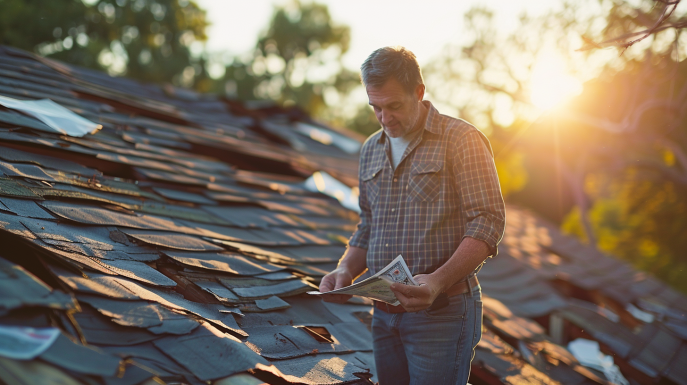
Insurance Sent Me A Check For Roof Now What?
Upon receiving a check from your insurance company for roof damage, carefully review the accompanying documentation to guarantee the payout aligns with the estimated repair costs and the terms outlined in your policy.
This includes verifying if the deductible amount is included in the check, as you are responsible for paying that out-of-pocket before insurance coverage kicks in.
Claim Review Checklist
| Item | Description | Action |
|---|---|---|
| Deductible | Check if deductible is included | Verify with insurance company |
| Repair Costs | Compare payout with estimated costs | Review policy terms and adjust accordingly |
| Communication | Record all communication with insurance company | Update claim records |
If the check does not cover all necessary repairs or if there are disputes about the claim, consider consulting a public insurance adjuster or attorney for assistance in maximizing your settlement. Thorough documentation of any damage, including photos and repair estimates, can help in negotiating further if the initial payout is insufficient.
Keep track of all communications with your insurance company regarding the claim, as maintaining a clear record can be vital for any follow-up discussions or potential appeals.
Roofer Wants Me To Sign Over Insurance Check?
Carefully consider the implications before signing over an insurance check to a roofer, as this action may inadvertently compromise your negotiating power and potentially violate Texas laws governing deductible payments and contractor practices.
In Texas, contractors are prohibited from acting as public adjusters, and signing over the check could enable them to bypass legal regulations governing insurance claims.
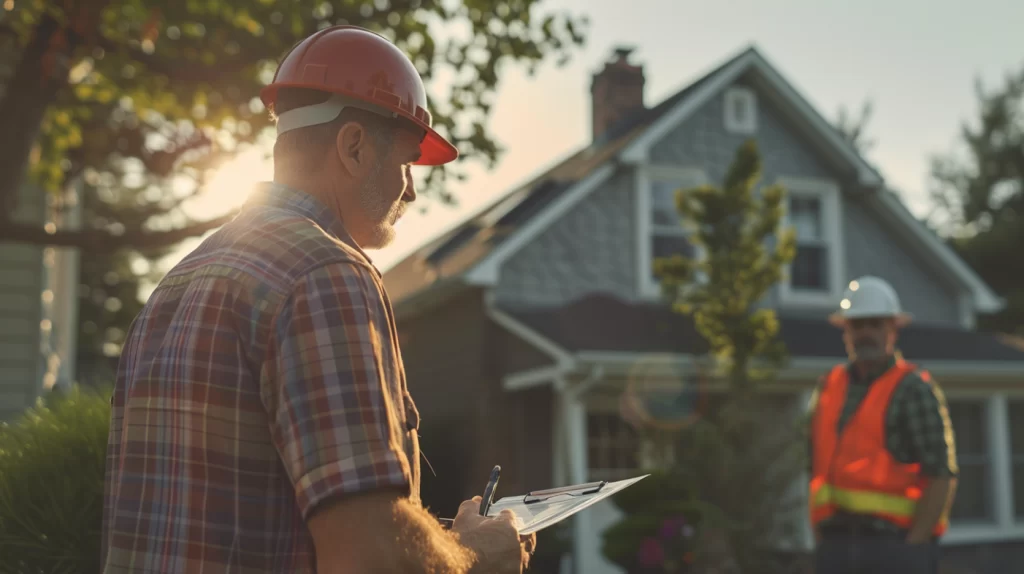
Before making a decision, consider the following:
- Signing over the check may limit your ability to negotiate the claim and guarantee that all necessary repairs are made.
- Texas law requires that only licensed public adjusters can negotiate claims on behalf of policyholders.
- Allowing a roofer to receive direct payments from insurers may lead to conflicts of interest and inadequate repairs.
- It is advisable to consult a licensed public adjuster or legal professional to guarantee compliance and protect your rights.
To avoid potential pitfalls, it is essential to understand the Texas Insurance Code and the roles of public adjusters and contractors in the claims process. By being informed, you can make an empowered decision and guarantee a successful outcome for your roof damage insurance claim.
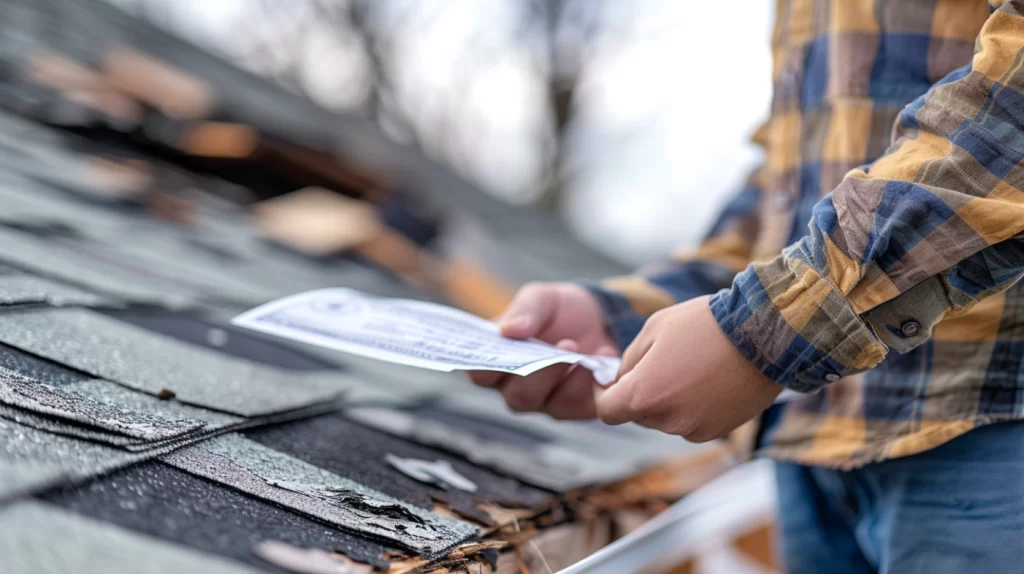
Can You Keep Insurance Claim Money For Roof?
Following a successful insurance claim, homeowners often wonder if they can retain the claim money allocated for roof repairs, and the answer largely depends on the specific terms of their insurance policy and the intended use of the funds.
Typically, insurance policies require that payouts be used to restore the property to its pre-damage condition.
However, homeowners are not always required to show receipts for all expenses.
| Insurance Policy Requirements | Homeowner Obligations | Consequences of Non-Compliance |
|---|---|---|
| Use funds for intended repairs | Document repairs and replacements | Voiding of policy or penalties |
| Restore property to pre-damage condition | Meet deductible obligations | Reduction of insurance payout |
| Comply with policy terms | Retain records of expenses | Future disputes or denied claims |
It is vital for homeowners to understand their insurance policy’s requirements and obligations to avoid any potential consequences. By using claim money for its intended purpose and documenting repairs, homeowners can guarantee compliance with their policy and protect against future disputes.
How To Get Insurance To Pay For Roof Decking?
When seeking insurance coverage for roof decking damage, how can homeowners effectively navigate the claims process to maximize their chances of a successful payout? The key lies in thorough documentation and a clear understanding of the insurance policy’s terms.
To guarantee a smooth process, homeowners should:
- Document all storm-related damages, including photographs and repair estimates from licensed contractors.
- Thoroughly review the insurance policy to confirm coverage for structural damage, including roof decking.
- Keep detailed records of maintenance and repairs to demonstrate the roof’s condition prior to the damage.
- Obtain weather reports to confirm the occurrence of a storm event, which may be required to validate the claim.
- Engage a licensed public adjuster to navigate the claims process and advocate for maximum settlements.
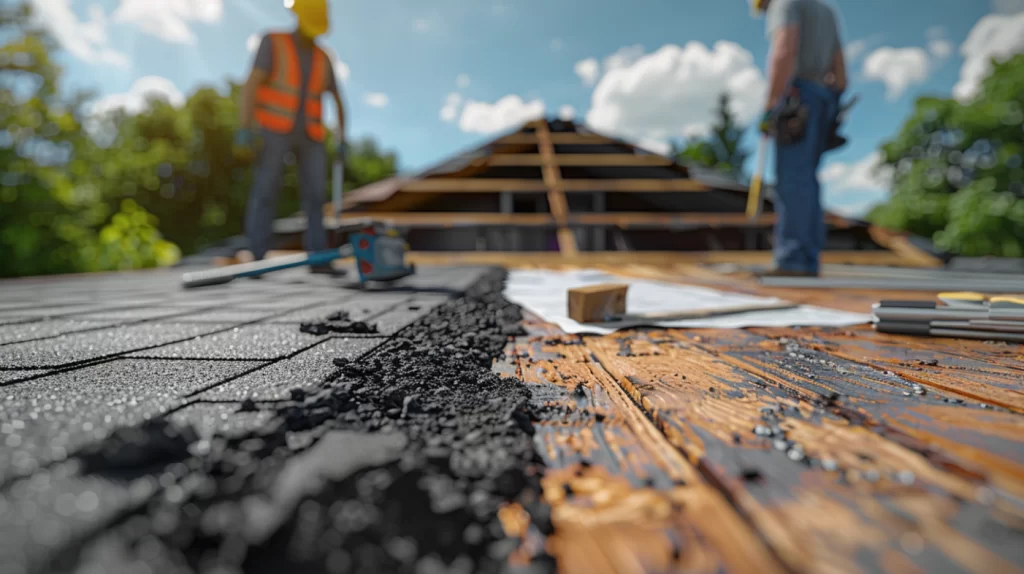
Insurance Claim Types We Specialize In
Your Insurance Company Has An Adjuster ... Shouldn’t You?
Our Expert Public Adjusters Work Exclusively For You To Ensure You Get The Highest Settlement Possible From Your Property Insurance Claim After A Disaster.
Select Your State:
Learn more about what our expert public adjusters can do for your residential insurance claims!
Learn about what our expert public adjusters can do for your commercial insurance claims!
Learn about what our public adjusting roofing specialists can do for you & your roofing claims!
Insurance adjusters work for THEM, our public adjusters work for YOU! Here’s how …